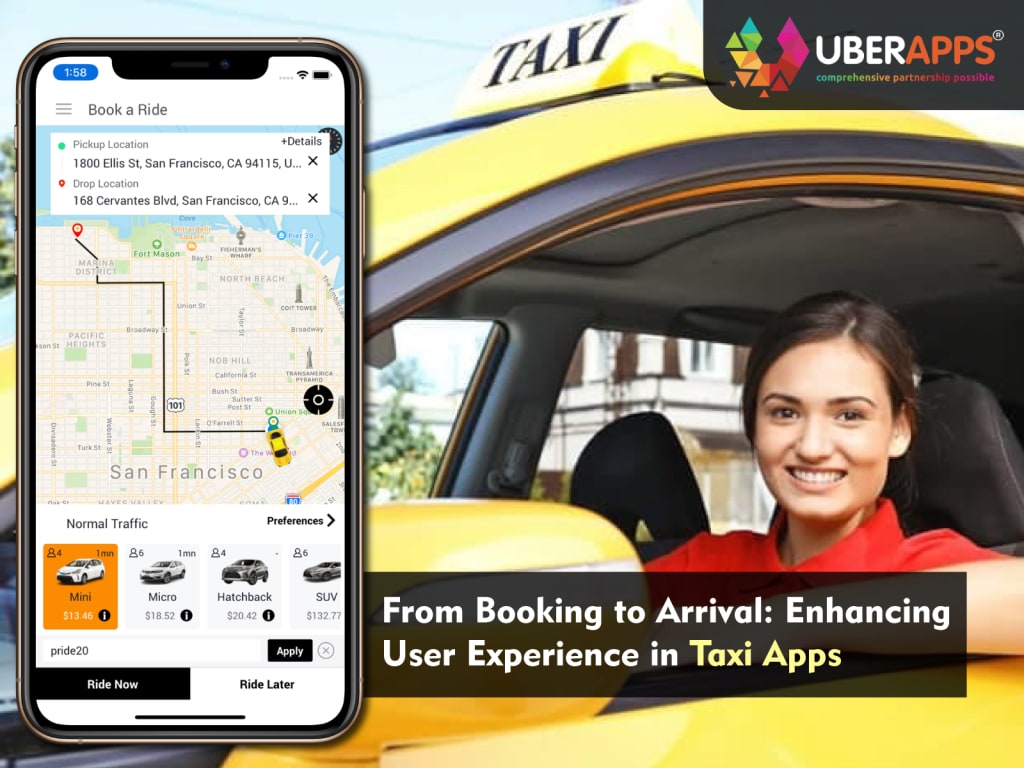From Booking to Arrival: Enhancing User Experience in Taxi Apps
From Booking to Arrival: Enhancing User Experience in Taxi Apps

In the competitive world of ride-hailing services, user experience (UX) is paramount. From the moment a user opens the app to the arrival at their destination, every interaction shapes their perception of the service. Effective taxi app development, including Uber clones, hinges on creating a seamless, intuitive, and efficient user journey. This blog explores how to enhance the user experience in taxi apps from booking to arrival, ensuring that users return time and again.
The Importance of User Experience in Taxi Apps
User experience is the sum of all interactions a user has with an app. For taxi apps, this includes searching for a ride, booking it, tracking the driver, making payments, and rating the service. A positive user experience leads to higher customer satisfaction, increased retention rates, and positive word-of-mouth referrals. On the other hand, a poor experience can lead to negative reviews and a decline in users.
Key Aspects of Enhancing User Experience
1. Intuitive Interface Design
The interface is the first point of contact between the user and the app. An intuitive and user-friendly design is crucial for making a good first impression.
Simplified Navigation: Ensure that users can easily navigate through the app. Important functions like booking a ride, setting a destination, and viewing trip details should be accessible within a few taps.
Clear Visuals: Use clear icons and labels to guide users through the process. Avoid clutter and ensure that the design is clean and visually appealing.
2. Streamlined Booking Process
The booking process should be quick and straightforward, minimizing the effort required from the user.
Quick Registration: Allow users to sign up using their email, phone number, or social media accounts. The registration process should be fast and hassle-free.
One-Tap Booking: Implement one-tap booking options where users can select their pickup and drop-off locations quickly. Use saved locations and predictive addresses to speed up the process.
Fare Estimates: Provide clear and upfront fare estimates before booking. This transparency helps build trust with users.
3. Real-Time GPS Tracking
Real-time tracking is a critical feature that enhances the sense of security and reliability.
Accurate Location Services: Use high-precision GPS services to provide accurate real-time tracking of the driver’s location. This reduces uncertainty and anxiety for the user.
Estimated Time of Arrival (ETA): Display the ETA prominently on the screen and update it in real-time. Users appreciate knowing exactly when their ride will arrive.
4. Multiple Payment Options
Offering a variety of payment options caters to different user preferences and enhances convenience.
Diverse Payment Methods: Include options for credit/debit cards, digital wallets, cash, and in-app wallets. This flexibility makes it easier for users to pay for their rides.
Secure Transactions: Ensure that all payment methods are secure and comply with industry standards to protect user data.
5. In-App Communication
Effective communication between drivers and passengers can resolve many potential issues and improve the overall experience.
In-App Chat and Call: Provide in-app chat and call features that allow passengers to communicate with drivers without sharing personal contact information. This can help clarify pickup locations and provide updates.
Automated Messages: Use automated messages to keep users informed about important updates, such as driver arrival or changes in ride status.
6. Rating and Feedback System
A robust rating and feedback system ensures that service quality is maintained and helps identify areas for improvement.
Post-Ride Feedback: Allow users to rate their ride and provide feedback immediately after the trip. Ensure that the rating process is quick and easy.
Driver Feedback: Enable drivers to rate passengers as well. This mutual rating system helps maintain respectful interactions and service quality.
7. Safety Features
Safety is a top priority for taxi apps, and incorporating advanced safety features can significantly enhance user trust.
SOS Button: Include an emergency button that passengers can use to alert authorities or emergency contacts in case of distress.
Ride Sharing: Allow users to share their trip details and real-time location with friends or family. This provides an added layer of security.
Driver Verification: Implement thorough background checks and regular screenings for drivers to ensure passenger safety.
8. Driver Management
Providing tools for drivers to manage their work effectively contributes to a better user experience for passengers.
Earnings Tracking: Offer features that allow drivers to track their earnings in real-time. Transparent earnings reports help build trust and satisfaction among drivers.
In-App Navigation: Integrate reliable and updated navigation systems to help drivers find the best routes and avoid traffic.
Availability Settings: Allow drivers to easily toggle their availability status. This helps manage expectations and improves the efficiency of the service.
Case Study: Implementing Enhanced UX in Uber Clones
To illustrate how these features can be implemented effectively, let's consider the case of an Uber clone app. The development team focuses on creating a streamlined user journey:
User-Friendly Interface: The app’s design is clean, with large buttons and clear icons. The booking screen features a map with the user’s current location highlighted, and commonly used destinations are suggested automatically.
Real-Time Tracking: High-precision GPS technology ensures that users can track their drivers accurately. The ETA is displayed prominently and updated in real-time.
Multiple Payment Options: Users can choose from several payment methods, including digital wallets, which are popular among younger users.
Safety Features: An SOS button is available on the main screen, and users can share their trip details with friends and family directly from the app.
Conclusion
Enhancing user experience in taxi apps involves a comprehensive approach that addresses every touchpoint in the user journey. From intuitive design and streamlined booking processes to advanced safety features and effective communication tools, each element plays a crucial role in creating a positive and memorable experience. As taxi app development continues to evolve, focusing on user experience will be key to building loyal user bases and achieving long-term success. Whether developing an Uber clone or a unique taxi app, these strategies will help ensure that your app stands out in the competitive ride-hailing market.
About the Creator
Rishabh Jain
I am an experienced content writer, enjoys sharing his thoughts on various taxi app development,online delivery firms, eCommerce, on-demand business models, and so on. https://www.uberapps.tech/
Enjoyed the story? Support the Creator.
Subscribe for free to receive all their stories in your feed. You could also pledge your support or give them a one-off tip, letting them know you appreciate their work.






Comments
There are no comments for this story
Be the first to respond and start the conversation.